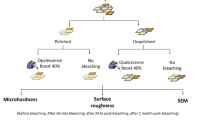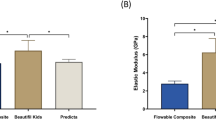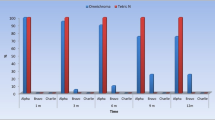Abstract
Objectives The aim of this in vitro study was to evaluate the effects of five different two-step diamond impregnated polishing systems (Sof-Lex Spiral, Venus Supra, Komet Spiral, CompoMaster and Shapeguard) on the surface roughness and morphology of a submicron hybrid composite resin material (Brilliant Everglow).
Materials and methods Two-hundred composite resin discs were prepared with 180 SiC paper to produce a uniform baseline surface. The samples were randomly assigned to one of five groups and polishing was completed by one operator. The arithmetic mean surface roughness (Ra) was measured using contact profilometry and the surfaces were examined under an SEM.
Results Statistical differences (p <0.05) were identified between the surface roughness remaining after use of the polishers. Diatech Shapeguard (0.22 μm, SD 0.08) and Komet Spiral (0.26 μm, SD 0.09) polishers yielded the lowest Ra values, while the CompoMaster polishing system led to the highest surface roughness values (0.55 μm, SD 0.19).
Conclusions Within the limits of this in vitro study of the efficacy of diamond impregnated two-step polishing systems, Diatech Shapeguard and Komet Spiral polishing systems produced the lowest surface roughness values. These polishing systems yielded acceptable surface roughness values with regards to oral health and patient comfort.
Clinical relevance Similarly designed polishing systems do not produce comparable surface roughness levels and clinicians should be aware of this when considering polishing protocols for composite restorations.
This is a preview of subscription content, access via your institution
Access options
Subscribe to this journal
Receive 24 print issues and online access
$259.00 per year
only $10.79 per issue
Buy this article
- Purchase on Springer Link
- Instant access to full article PDF
Prices may be subject to local taxes which are calculated during checkout






Similar content being viewed by others
References
Eltahlah D, Lynch C D, Chadwick B L, Blum I R, Wilson N H F. An update on the reasons for placement and replacement of direct restorations. J Dent 2018; 72: 1-7.
Jefferies S R. The art and science of abrasive finishing and polishing in restorative dentistry. Dent Clin North Am 1988; 42: 613-627.
Konishi N, Torii Y, Kurosaki A, Takatsuka T, Itota T, Yoshiyama M. Confocal laser scanning microscopic analysis of early plaque formed on resin composite and human enamel. J Oral Rehabil 2003; 30: 790-795.
Montanaro L, Campoccia D, Rizzi S et al. Evaluation of bacterial adhesion of streptococcus mutans on dental restorative materials. Biomaterials 2004; 25: 4457-4463.
Spencer P, Ye Q, Misra A, Goncalves S E P, Laurence J S. Proteins, pathogens, and failure at the composite-tooth interface. J Dent Res 2014; 93: 1243-1249.
Quirynen M, Marechal M, Busscher H J, Weerkamp A H, Darius P L, Steenberghe D. The influence of surface free energy and surface roughness on early plaque formation. J Clin Periodontol 1990; 17: 138-144.
Bolleni C M L, Lambrechts P, Quirynen M. Comparison of surface roughness of oral hard materials to the threshold surface roughness for bacterial plaque retention: A review of the literature. Dent Mat 1997; 13: 258-269.
Quirynen M, Bollen C M L. The influence of surface roughness and surface-free energy on supraand subgingival plaque formation in man. J Clin Periodontol 1995; 22: 1-14.
Hannig C, Hannig M. The oral cavitya key system to understand substratum-dependent bioadhesion on solid surfaces in man. Clin Oral Invest 2009; 13: 123-139.
Jones C S, Billington R W, Pearson G J. The in vivo perception of roughness of restorations. Br Dent J 2004; 196: 42-45.
Lu H, Roeder L, Lei L, Powers J. Effect of surface roughness on stain resistance of dental resin composites. J Esthet Rest Dent 2005; 17: 102-108.
Karaman E, Tuncer D, Firat E, Ozdemir O S, Karahan S. Influence of different staining beverages on colour stability, surface roughness and microhardness of silorane and methacrylate-based composite resins. J Contemporary Dent Pract 2014; 15: 319-325.
Reis A F, Giannini M, Lovadino J R, Ambrosano G M. Effects of various finishing systems on the surface roughness and staining susceptibility of packable composite resins. Dent Mat 2003; 19: 12-18.
Barakah H M, Taher N M. Effect of polishing systems on stain susceptibility and surface roughness of nanocomposite resin material. J Prosthet Dent 2014; 112: 625-631.
O'Brien W J, Johnston W M, Fanian F, Lambert S. The surface roughness and gloss of composites. J Dent Res 1984; 63: 685-688.
Heintze S D, Forjanic M, Rousson V. Surface roughness and gloss of dental materials as a function of force and polishing time in vitro. Dent Mat 2006; 22: 146-165.
Pala K, Tekçe N, Tuncer S, Serim M E, Demirci M. Evaluation of the surface hardness, roughness, gloss and colour of composites after different finishing/polishing treatments and thermocycling using a multitechnique approach. Dent Mat J 2016; 35: 278-289.
Antonson S A, Yazici A R, Kilinc E, Antonson D E, Hardigan P C. Comparison of different finishing/polishing systems on surface roughness and gloss of resin composites. J Dent 2011; DOI: 10.1016/j.jdent.2011.01.006.
Takanashi E, Kishikawa R, Ikeda M et al. Influence of abrasive particle size on surface properties of flowable composites. Dent Mat J 2008; 27: 780-786.
Chung K. Effects of finishing and polishing procedures on the surface texture of resin composites. Dent Mat 1994; 10: 325-330.
Kaizer M R, de Oliveira-Ogliari A, Cenci M S, Opdam N J M, Moraes R R. Do nanofill or submicron composites show improved smoothness and gloss? A systematic review of in vitro studies. Dent Mat 2014; DOI: 10.1016/j.dental.2014.01.001.
Tjan A H L, Chan C A. The polishability of posterior composites. J Prosthet Dent 1989; 61: 138-146.
Daud A, Grey G, Lynch C D, Wilson N H F, Blum I R. A randomised controlled study on the use of finishing and polishing systems on different resin composites using 3D contact optical profilometry and scanning electron microscopy. J Dent 2018; 71: 25-30.
Kemaloglu H, Karacolak G, Turkun L S. Can reduced-step polishers be as effective as multiple-step polishers in enhancing surface smoothness? J Esthet Restor Dent 2017; 29: 31-40.
Can Say E, Yurdagüven H, Yaman B C, Özer F. Surface roughness and morphology of resin composites polished with two-step polishing systems. Dent Mat J 2014; 33: 332-342.
Zach L, Cohen G. Pulp response to externally applied heat. Oral Surgery 1965; 19: 515-530.
Jones C S, Billington R W, Pearson G J. The effects of lubrication on the temperature rise and surface finish of amalgam and composite resin. J Dent 2007; 35: 36-42.
Lopes I A D, Monteiro P, Mendes J J B, Gonçalves J M R, Caldeira F J F. The effect of different finishing and polishing techniques on surface roughness and gloss of two nanocomposites. Saudi Dent J 2018; 30: 197-207.
Teughals W, Van A N, Isabelle S, Marc Q. Effect of material characteristics and/or surface topography on biofilm development. Clin Oral Implant Res 2006; 17: 68-81.
Author information
Authors and Affiliations
Corresponding author
Rights and permissions
About this article
Cite this article
Wheeler, J., Deb, S. & Millar, B. Evaluation of the effects of polishing systems on surface roughness and morphology of dental composite resin. Br Dent J 228, 527–532 (2020). https://doi.org/10.1038/s41415-020-1370-8
Published:
Issue Date:
DOI: https://doi.org/10.1038/s41415-020-1370-8



